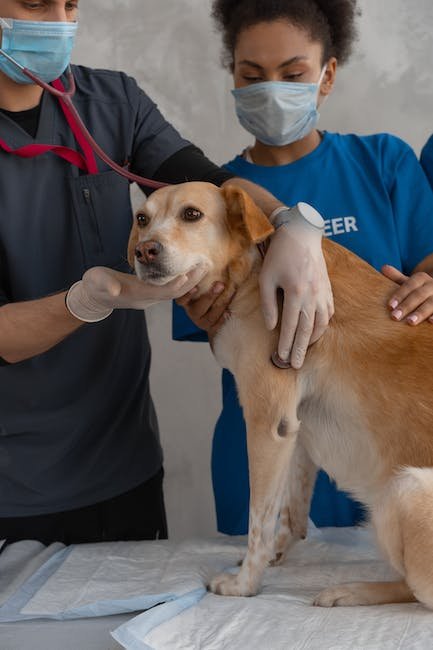A chill runs down his spine as the unfamiliar smell of antiseptic tickles his nostrils. His eyes dart nervously from the bustling reception area to the glimmering silver instruments lining the sterile white walls. The once-confident and playful puppy now quivers with fear, his tail tucked tightly between his trembling paws. For many dogs, a trip to the veterinary clinic can transform even the bravest canine hearts into pounding pockets of anxiety. But fret not, as we delve into the world of puppy training, arming you with invaluable tips and techniques to conquer the fear, rendering those veterinary visits less scary for both you and your furry companion.
Table of Contents
- Understanding the Source of Anxiety: Identifying the Triggers and Root Causes of Vet Fear in Puppies
- Creating Positive Associations: Using Treats and Rewards to Reinforce a Positive Vet Experience
- Gradual Exposure and Desensitization: Step-by-Step Approach to Reducing Fear in Vet Visits
- Building Trust: Developing a Strong Bond with Your Puppy to Ease Vet Anxiety
- Professional Guidance: Seeking Help from a Certified Dog Trainer or Behaviorist for Vet Fear Management
- Q&A
- In Conclusion

Understanding the Source of Anxiety: Identifying the Triggers and Root Causes of Vet Fear in Puppies
Anxiety in puppies can manifest in various ways and can be triggered by a range of factors. It is crucial for pet owners to understand the source of anxiety in their furry friends to provide them with the necessary support and care. Identifying the triggers and root causes of anxiety in puppies is the first step towards creating a safe and secure environment for them.
One common trigger of vet fear in puppies is a lack of early socialization. Puppies who have not been exposed to different people, animals, and environments during their critical development stages are more prone to feelings of fear and anxiety. Additionally, negative experiences during these early stages, such as loud noises or rough handling, can also contribute to the development of vet fear.
In some cases, genetics may play a role in a puppy’s susceptibility to anxiety. Certain breeds are more prone to anxious behavior, while others may have a predisposition to specific fears, such as loud noises or unfamiliar spaces. Understanding the breed characteristics and potential genetic factors can provide valuable insights into the root causes of anxiety in puppies.
To effectively address anxiety in puppies, it is essential to create a comprehensive plan that includes gradual exposure to triggering stimuli, positive reinforcement, and professional guidance if necessary. By identifying the triggers and root causes of vet fear in puppies, pet owners can provide the necessary support and help their furry companions lead happier, healthier lives.

Creating Positive Associations: Using Treats and Rewards to Reinforce a Positive Vet Experience
When it comes to visiting the vet, many pets can feel anxious or reluctant. However, by incorporating treats and rewards into their vet experience, we can create positive associations that help reduce anxiety and build trust. By using positive reinforcement techniques, we can transform what was once a stressful trip into a pleasant and rewarding experience for both pets and their owners.
One effective way to start creating positive associations at the vet is by using treats. Bringing along your pet’s favorite treats can help distract and comfort them during their visit. Offer these treats throughout the appointment, especially during moments that may be more challenging or anxiety-inducing, such as during procedures or when meeting new staff members. Be sure to choose treats that are easily digestible and safe for your pet, and consult with the vet if you have any concerns.
- Variety is key: Dogs and cats have different preferences, so be sure to have an assortment of treats to cater to their individual tastes.
- Timing is everything: Give treats immediately after a positive experience or during moments when your pet is calm and relaxed to reinforce their positive behavior and create positive associations.
- Consistency is crucial: Set a routine by consistently using treats and rewards during vet visits to help your pet associate the clinic with positive experiences over time.
Remember, the goal is to create a positive vet experience by using treats and rewards as tools to reduce anxiety and build trust. By implementing these techniques, we can help our furry friends feel more comfortable and at ease during their visits, ensuring a healthier and happier life for them.

Gradual Exposure and Desensitization: Step-by-Step Approach to Reducing Fear in Vet Visits
Vet visits can be a source of anxiety and fear for many pets. However, with a gradual exposure and desensitization approach, we can help your furry friend overcome their fears and make their vet visits a more positive experience.
1. Create a calm environment: Start by creating a calming atmosphere at home. Play soft music, use pheromone sprays, and provide comfort items like blankets or toys to help your pet feel secure. This will help set the stage for a successful desensitization process.
2. Introduce the carrier: Next, gradually introduce your pet to their carrier. Place it in a common area and make it a positive space by placing treats or their favorite toys inside. Encourage them to explore and enter the carrier on their own terms. This step helps reduce the association of the carrier with fear or discomfort.
3. Short car rides: Once your pet is comfortable with the carrier, take them on short car rides. Start with just a few minutes and gradually increase the duration. This will help them become accustomed to the sensation of being in a moving vehicle and will reduce anxiety associated with car travel.
4. Practice handling exercises: To prepare your pet for the vet examination, practice gentle handling exercises at home. Gradually introduce touch, starting with areas your pet feels comfortable being touched. Reward them for their calm behavior and gradually work on touching sensitive areas such as paws, ears, or belly.
5. Visit the clinic: Finally, schedule visits to the vet clinic without any procedures involved. This will allow your pet to become familiar with the sights, smells, and sounds of the clinic and help build positive associations. Reward their calm behavior during these visits and gradually increase the duration of each visit.
Remember, patience is key throughout this process. Each pet is unique and may require different timelines for desensitization. By using this step-by-step approach, you can help your pet overcome their fear of vet visits and create a more positive experience for both of you.
Building Trust: Developing a Strong Bond with Your Puppy to Ease Vet Anxiety
Bringing your furry friend to the veterinarian can be a stressful experience, both for you and your puppy. However, by focusing on building a strong bond with your little one, you can help alleviate their anxiety and make vet visits a more positive and calm experience. Here are a few guidelines to consider:
- Start early: Beginning to build trust from the moment you bring your puppy home is crucial. Take time to establish a routine and introduce gentle handling, like lifting their paws or checking their ears, so they become accustomed to being touched.
- Positive reinforcement: Use treats, toys, or praise to reward your puppy when they exhibit calm behavior during handling exercises. This positive reinforcement will help them associate being touched with something enjoyable, reducing their anxiety during veterinary exams.
- Socialize, socialize, socialize: Expose your puppy to different people, animals, and environments to help them become well-adjusted and confident. By creating positive experiences with strangers and other dogs, your puppy will be more at ease when meeting the veterinarian and their staff.
Remember, building trust takes time and consistency. Celebrate small victories along the way, such as your puppy voluntarily approaching you for affection or remaining calm during routine grooming. By establishing a strong bond with your puppy, you can minimize their vet anxiety and ensure they receive the best care possible.
Professional Guidance: Seeking Help from a Certified Dog Trainer or Behaviorist for Vet Fear Management
Seeking professional guidance from a certified dog trainer or behaviorist can be invaluable when it comes to managing your dog’s fear of the vet. These experts have the knowledge and experience to address your dog’s specific needs and tailor a training plan that suits their temperament.
When choosing a certified dog trainer or behaviorist, consider the following:
- Qualifications: Look for someone who is certified by reputable organizations such as the Certification Council for Professional Dog Trainers (CCPDT) or the International Association of Animal Behavior Consultants (IAABC).
- Experience: Find someone who has extensive experience working with fearful dogs or specifically in vet fear management.
- Positive reinforcement techniques: Ensure that the trainer or behaviorist uses force-free, positive reinforcement-based training methods rather than punitive or aversive techniques.
During the consultation with the trainer or behaviorist, they will typically perform a thorough evaluation of your dog’s behaviors, triggers, and responses to vet-related situations. Based on this assessment, they will develop a customized training plan that may include counter-conditioning, desensitization exercises, and teaching relaxation techniques.
Remember, seeking professional guidance is not a sign of failure as a pet owner, but rather a proactive step towards helping your dog overcome their fear and anxiety. With the right support and guidance, you can create a positive and stress-free experience for your furry friend during vet visits.
Q&A
What is the reason behind puppies being scared of vets?
Puppies can be scared of vets due to the unfamiliar environment, strange smells, and past negative experiences such as vaccinations or discomfort during physical examinations.
Is it common for puppies to be fearful of vet visits?
Yes, it is quite common for puppies to be fearful of vet visits. The clinic setting, along with the presence of unfamiliar people and medical procedures, can be overwhelming for them.
How can I help my puppy overcome the fear of vet visits?
You can start by gradually exposing your puppy to the vet’s office, allowing them to explore and associate positive experiences with the environment. Rewarding them with treats and praise during short visits can also help them feel more comfortable.
Are there any specific training techniques I can use?
Positive reinforcement training techniques, such as counter-conditioning and desensitization, can be effective. Reward your puppy for calm behavior during vet-related activities or interactions, gradually increasing their exposure to these situations.
Should I discuss my puppy’s fear with the vet?
Absolutely! It is important to inform your vet about your puppy’s fear and any past negative experiences. By working together, your vet can take steps to create a more positive and stress-free experience for your puppy during visits.
Are there any signs I should look for to know if my puppy is anxious during vet visits?
Some signs of anxiety in puppies during vet visits include trembling, excessive panting, excessive drooling, attempts to hide, or becoming more vocal. These signs indicate that your puppy may be feeling scared or anxious.
Can I bring something comforting along during vet visits to help my puppy?
Yes, bringing along their favorite toy or a blanket with familiar scents can help provide comfort and familiarity during vet visits. However, always check with the vet beforehand to ensure it won’t interfere with any necessary procedures.
Is it important to maintain regular vet visits even if my puppy is fearful?
Regular vet visits are essential for the overall health and well-being of your puppy, even if they are fearful. With patience and appropriate training, you can gradually work towards making these visits less scary for your puppy.
In Conclusion
As we bid farewell to this guide on puppy training to conquer the fear of vets, we hope that you and your furry companion embark on a journey of bravery and resilience together. Remember, every step counts and every effort is worthwhile in making vet visits less daunting for your canine friend.
By implementing positive reinforcement techniques, creating a relaxing atmosphere at home, and gradually exposing your pup to vet-related experiences, you can turn dreaded vet visits into a harmonious dance of trust and understanding. The road may not always be easy, but the reward of a fearless and confident four-legged companion will be immeasurable.
Imagine a day when your pup walks into the vet’s office with a spring in their step, tail wagging with excitement. Picture yourself standing beside your furry best friend, sharing a proud and affectionate moment, knowing that their fear has been conquered, and you have been their guiding light.
So, don’t be disheartened by setbacks or roadblocks along the way. Remember, Rome wasn’t built in a day, and neither is a brave and fearless companion. With your patience, love, and unwavering dedication, you can shape your pup’s perception of vet visits, transforming each appointment into an opportunity for growth and triumph.
As you embark on this training journey, embrace each challenge as an opportunity to build an unbreakable bond with your beloved pup. Celebrate the small victories, cherish the progress, and don’t forget to shower your furry warrior with abundant praise and rewards.
In this realm of puppy training, where fear and anxiety are tackled with gentle determination, you hold the power to change your pup’s perception of the veterinary visit. Harness that power, and together, you and your pup shall conquer the realm of vet visits, turning fear into courage and anxiety into serenity.
While this article may have reached its end, your adventure in easing your pup’s fear of the vet is just beginning. So gear up with positivity, patience, and an unwavering belief in your pup’s potential. Together, you shall navigate the winding roads, overcome obstacles, and triumph over fear, ensuring that your furry friend receives the medical attention they deserve with confidence and tranquility.
May this journey be a tale of triumph, resilience, and the boundless love between you and your pup. Good luck, and may each veterinary visit bring you one step closer to a world where fear has no place in your furry companion’s heart.
As an affiliate, my content may feature links to products I personally use and recommend. By taking action, like subscribing or making a purchase, you’ll be supporting my work and fueling my taco cravings at the same time. Win-win, right?
Want to read more? Check out our Affiliate Disclosure page.
